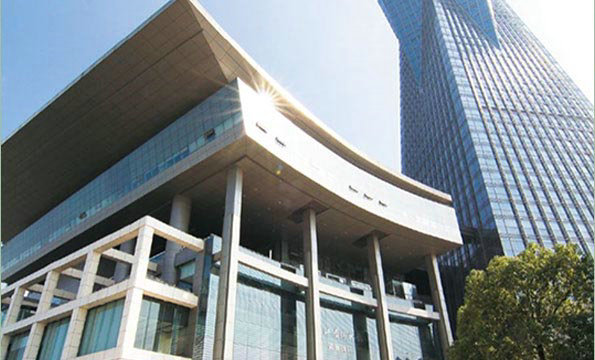Zhejiang Provincial Museum

One of China's oldest museums, Zhejiang Provincial Museum was founded in 1929 as the West Lake Museum of Zhejiang Province. Over the past eight decades, it has become the largest comprehensive museum for the humanities in Zhejiang. It is also a first-class National Museum that was developed jointly by central and local government.
The Gushan branch of Zhejiang Provincial Museum is located at the southern foot of Gushan Mountain. Most of its current buildings were rebuilt or expanded in 1993. It has a special garden-like layout consisting of individual buildings in a style characteristic of the region south of the Yangtze, and long winding corridors. In the west of its premises is the historic architectural complex of Wenlan Tower, which used to be the imperial library of the Qing dynasty and is now under national priority protection as a historic site. In the east is Zhejiang West Lake Gallery, which mainly features special art exhibitions. The elegant buildings nestling among the hills by the lake form an appealing cultural attraction in Hangzhou.
The Wulin branch, which was completed and opened to the public towards the end of 2009, is located downtown at the West Lake Culture Square. It is mainly used for exhibitions about Zhejiang's history and traditional culture, its modern revolutionary history, and its intangible heritage. It is a new venue for displaying Zhejiang's long history, splendid culture and revolutionary course as well as a new public space for the arts and humanities. Adjacent to the Grand Canal, the modernized buildings of the Wulin branch are filled with a vitality that encompasses both past and present.
Besides the two branches, Zhejiang Provincial Museum also includes Huang Binhong Memorial at Qixia Ridge, the former residence of Sha Menghai on Longyou Road, and the Research Centre for the Preservation of Cultural Heritage at Gudang. The total floor space is over 40,000 m2.
Zhejiang Provincial Museum houses over 100,000 items of cultural heritage, which cover a wide range and represent a complete sequence of eras. Among them are precious items with distinct regional features and significant academic value, such as the pottery, lacquer ware, wooden ware, bone tools and ivory artefacts of the Hemudu culture, the jade ware of the Liangzhu culture, the bronzes and primitive porcelain of the Kingdom of Yue, the celadon of the Yue, Longquan and other kilns, mirrors made in Huiji and Huzhou, gold and silver coins of the Southern Song dynasty, and paintings and calligraphic works by Zhejiang artists of the Ming and Qing dynasties. These treasures reflect the political, economic and cultural landscapes of Zhejiang during various historical periods and reveal the profound culture of the region.
Zhejiang Provincial Museum has always placed a premium on academic studies. The study of its collection, of history and culture, and of museology, has contributed to the preservation and exhibition of its collection and strengthened its function for social education, cultural dissemination and the continuity of civilization. Several of the museum's projects in the area of technological preservation of cultural relics have won awards. Its project 'Research into the Outdoor Refrigeration and Dehydration of Water-saturated Wooden Relics from Hemudu' was awarded the Third National Prize for Scientific and Technological Progress; another project, 'Research into a Mould-proof and Mothproof Adhesive for Mounting with Lasting Effect', was awarded the First Prize for Scientific and Technological Progress by the State Administration of Cultural Heritage. In terms of the humanities, the museum has also achieved ample results including the accomplishment of a dozen key national research projects and the publication of a large number of monographs.
In recent years, following the 'People First' principle, Zhejiang Provincial Museum has made every effort to fulfil its social responsibilities as a public cultural institution. On 1 January 2004, it became the first provincial museum in China to offer permanent free admission, which marked a significant step for the development of Chinese museums. Since then no effort has been spared to create classic exhibitions ('The Song of Yue: the History and Culture of Zhejiang', an exhibition reflecting Zhejiang's history and culture, was designated as a classic in the ninth round (2009–10) of the event for selecting the Top Ten Exhibitions of Chinese Museums). In addition, it has showcased the long and profound Chinese culture as well as world civilizations with varied and distinct features through a series of original or travelling exhibitions marked by rich content, diverse forms, clear themes and excellent design. Furthermore, thanks to the active exploration of new means and methods for social education, the museum has become an important site for education in culture and art, spiritual civilization and patriotism as well as an important centre of education and practice for various kinds of primary and secondary schools and institutions of higher learning.
Latest
- Live Broadcast Held by Cambodia Rural Road Project of the Belt and Road Overseas Engineering Science Camp
- Construction of China-Laos railroad heightens Chinese learning boom, Lao students grouped to Guangxi to study
- Opening Ceremony of Begonia Cultural Festival and Begonia Poetry Event Successfully Held
- Students from Indonesia arrive for study in China
Contact us
Address:ASEAN-China Centre, No. 43, Liangmaqiao Road, Chaoyang District, Beijing, China
Postcode: 100600
Tel: 86-10-65321660 ext 636
Fax: 86-10-85322527
Weibo: weibo.com/aseanchinacentre
